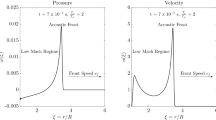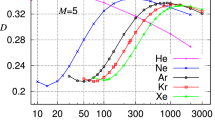Abstract.
An investigation of Mach number effects on the interaction of a shock wave with a cylindrical bubble, is presented. We have conducted simulations with the Euler equations for various incident shock Mach numbers (\(M_S\)) in the range of \( 1.22 \le M_S \le 6\), using high-resolution Godunov-type methods and an implicit solver. Our results are found in a very good agreement with previous investigations and further reveal additional gasdynamic features with increasing the Mach number. At higher Mach numbers larger deformations of the bubble occur and a secondary-reflected shock wave arises upstream of the bubble. Negative vorticity forms at all Mach numbers, but the “c-shaped” vortical structure appeared at \(M_S=1.22\) gives its place to a circular-shaped structure at higher Mach numbers. The computations reveal that the (instantaneous) displacements of the upstream, downstream and jet interfaces are not significantly affected by the incident Mach number for values (approximately) greater than \(M_S=2.5\). With increasing the incident Mach number, the speed of the jet (arising from the centre of the bubble during the interaction) also increases.
Similar content being viewed by others
Author information
Authors and Affiliations
Additional information
Received 21 December 2000 / Accepted 23 April 2001
Rights and permissions
About this article
Cite this article
Bagabir, A., Drikakis, D. Mach number effects on shock-bubble interaction. Shock Waves 11, 209–218 (2001). https://doi.org/10.1007/PL00004076
Issue Date:
DOI: https://doi.org/10.1007/PL00004076




